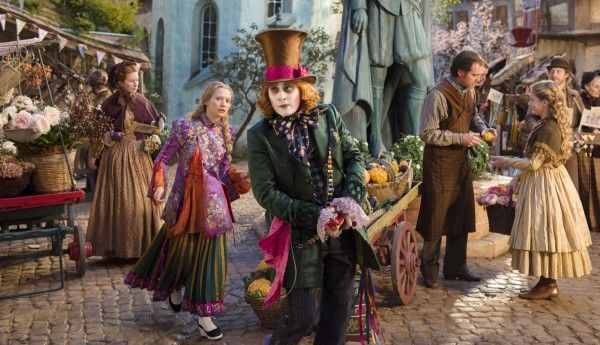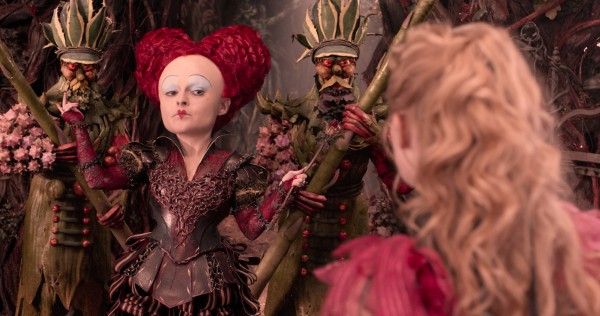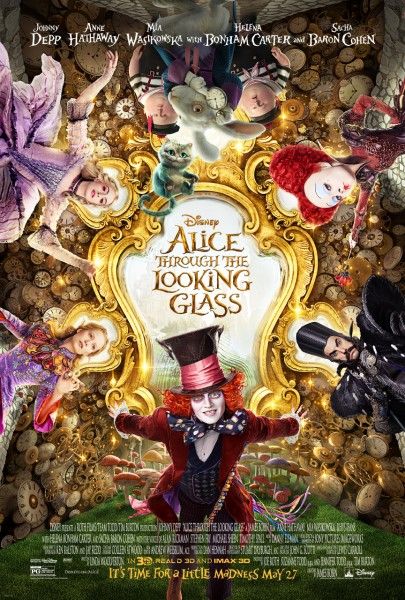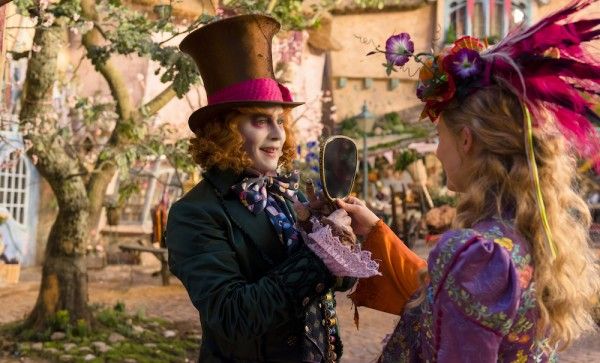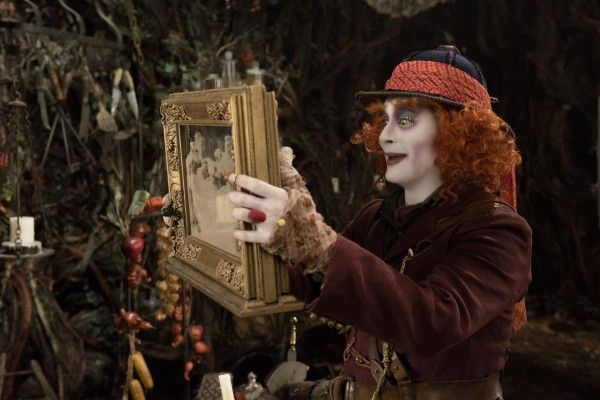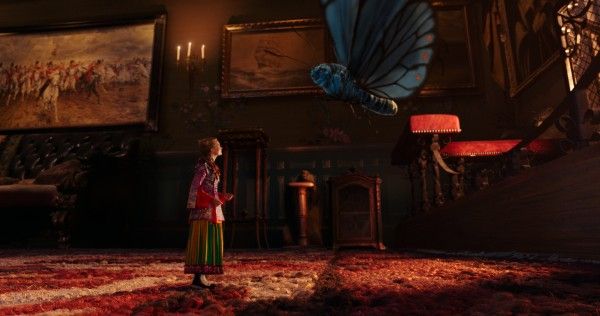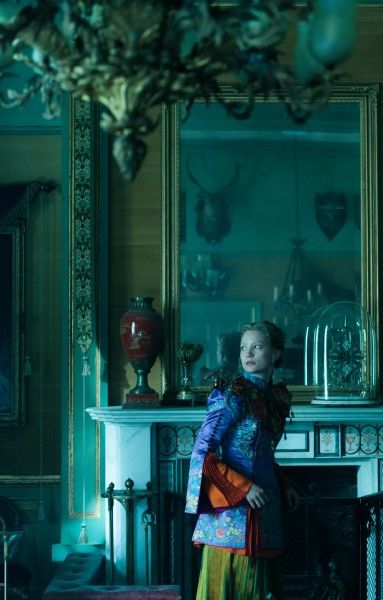In Alice Through the Looking Glass, the unforgettable characters from Lewis Carroll’s beloved stories have returned for an all-new adventure that sees Alice (Mia Wasikowska) return to the whimsical world of Underland to save her friend, the Mad Hatter (Johnny Depp). To help, the White Queen Mirana (Anne Hathaway) sends Alice on a mission to seek out Time himself (Sacha Baron Cohen), and she sets off on a very dangerous race where she must succeed before time runs out.
During a conference at the film’s Los Angeles press day, actresses Mia Wasikowska and Anne Hathaway were joined by director James Bobin and producer Suzanne Todd to talk about why it took so long to revisit this world and character, showing what a kick-ass girl can do, if she sets her mind to it, paying homage to the first film while making this their own, their own introduction to the work of Lewis Carroll, the bigger and bolder action, and the incredibly talented team behind the scenes. From the interview, we’ve compiled a list of 15 things that you should know about Alice Through the Looking Glass.
-
According to producer Suzanne Todd, who also had a hand in making the first film, it took so long to make this one because they wanted to make sure that they had an idea worth taking on first. They went back to the literature that’s been so popular for 150 years and looked at the themes there. As a result, they decide to focus on time, the preciousness of time and the importance of spending time with loved ones.
- Another important element to the story was showing what a kick-ass girl can do, if she sets her mind to it. Mia Wasikowska enjoyed getting to explore Alice’s strength. She said, “At the beginning of this film, she’s been traveling around the world for the last two years. She’s the captain of her own ship, so she’s coming from a very empowered place. I just love that she has this really strong sense of who she is. Despite the fact that expectations of her are really low when she returns to England, she’s able to honor up to that sense that she’s worth more than what other people want of her. I think she’s great.”
- Director James Bobin took over directing duties from Tim Burton, who directed the first film and remained a producer on this one. The project appealed to him because the story of Alice was such a part of his life growing up. He said, “It’s in your parents' house and grandparents' house, and you read the story to your own kids. I really felt that I knew who Alice was to me. The Alice in this film is really my idea of what Alice in the book would be like, if she’s grown up.”
- Everyone involved with the film was first introduced to Alice in very different ways. Bobin discovered a copy of the two books that his grandmother had, that was first read to him, as a young child. He was most struck by the images in the books and the work of the illustrator, which inspired the design ideas for this film. Todd went to Disneyland, starting when she was a young child, and rode the Alice rides – the Mad Tea Party and Alice in Wonderland – which inspired her to read the books. Wasikowska first saw an animated version of the film when she was young, and then read the books, reading them again before shooting the first movie. Anne Hathaway was reading an annotated version of Lolita in college that stated that Nabokov was really influenced by Lewis Carroll, and specifically by Alice in Wonderland, so she decided to read it to understand why. She connected with how well Lewis Carroll described madness.
- Alice was a real girl, who was the daughter of Charles Dodgson, Lewis Carroll’s boss. His daughter, Alice Liddell, was born in the 1850s, and he wrote Alice for and about her. Alice Liddell, the girl from the book, was born in 1852, and Emmeline Pankurst, who founded the Suffragette Society in England, was born in 1858. They are the same generation that got women the vote. The real Alice generation were women who were not prepared to put up with the status quo anymore. They knew things needed to changed, and they were going to make it different.
-
Bobin said that the humor in Lewis Carroll’s work also really spoke to him. “I remember reading Lewis Carroll as a kid, and he made me laugh. Obviously, a lot of stuff that I’ve done in the past has been to do with comedy, so I wanted to try to bring elements of that to this story. I always felt that he’s the author of absurdist, surrealist humor, which you can trace in a direct line to things like Monty Python, which was also a part of my growing up.”
- Even though there was a new director at the helm and some new cast members, much of the behind-the-scenes team returned. Danny Elfman came back to do the music score. Colleen Atwood, who won an Oscar for the first Alice, came back to do the costumes. Ken Ralston, who had been Oscar nominated for visual effects for the first movie, also returned. There was a new production designer, Dan Hennah, another Academy Award winner, who really helped Bobin honor what Burton had done in the first film, while still doing something fresh and new that was its own thing.
- According to Bobin, paying homage to what came before while still putting his own spin on it came down to getting the tone of the story right, which is an ongoing process throughout the production. He said, “The tone is a result of a million decisions you make, over the period of the production of the movie. It's something I was incredibly aware of. Obviously, Tim’s first movie looks so beautiful. It felt like good parameters with which I got to work. But this film is set in a different time period and geographical location, so I was allowed, as the director, to bring something of myself to it, as well. Of course, we really are standing on the shoulders of Lewis Carroll, which is open to interpretation, but I’m pretty familiar with his work. I wanted to pay tribute to him, in the sense that it would be a story that he would appreciate. Even though time travel is, as a literary conceit, later than him, as a mathematician, I think he would have appreciated the idea of time travel because it’s basically equations and physics. So, it was basically trying to incorporate elements of Lewis Carroll whilst maintaining the [Burton] world, but then bringing something of what you think those things are.”
- Making Time itself into a character was an idea that came directly from Lewis Carroll. Said Bobin, “Lewis Carroll wrote in the book, when Hatter meets Alice for the first time, ‘I’ve been stuck here since last March when Time and I quarreled.’” In the film, Sacha Baron Cohen plays Time.
- Getting to tell another story set in the whimsical world of Underland allowed for backstory that we didn’t get to see in the first film. Learning more about the White Queen was part of the fun of returning to the role for Hathaway, who said, “It was fun to learn that she’s not perfect. I think she’s lovely in the first one, but a bit oppressively good. It was nice to know that, like everyone, she’s got a past, she has regrets, she feels shame, and she feels guilt, and that you can be forgiven for these things. I actually was really thrilled that we were trying to see what the emotions were about with these characters that look so fantastical, but then feel so relatable.”
-
Even though their characters have a very tumultuous and adversarial sisterly relationship, Hathaway said that the same is not true for her relationship with co-star Helena Bonham Carter. “Helena is one of my favorite people on the planet Earth. The world is better because she's on it. She’s so inventive and fresh. She’s fresh, in all definitions. She’s got a wonderfully fresh mouth, she’s fearless, she’s vulnerable, and she’s friendly. I admire her so much. It was really exciting for me to get to have more scenes with her, this time around, because I got to work with an incredible actress, but also because I got to talk with her between takes, which I loved. We had a really nice time, crafting the sister relationship together, and trying to make something that felt true to us and that people would understand.”
- In a world that is a kaleidoscope of color, the costumes still manage to stand out, thanks to costume designer Colleen Atwood. Wasikowska appreciated the functionality of her costumes, this time around. She said, “In this one, I got to wear lots of trousers and things that were a lot more accessible. Alice, in this film, is really active. I had a suit at the beginning and at the end, and even that Oriental skirt is pants, so that was really great.” Hathaway added that her costume helped her to create her character. “I had certain ideas about who she was, and then as soon as I put on the dress, I just said, ‘Oh, she’s air.’ And then, I started to think about the relationship between her and [Iracebeth] and I thought, if you have a family member who has a very, very large personality and a lot of emotions, you compensate by taking up less space. Here’s somebody who’s literally turning herself into almost weightlessness, and yet, it’s still so ornamented. I just thought it was very rich and very airy, and that’s how I came up with my airhead.”
- Because Alice is very physically active in this film, the stunt work is bigger and bolder. While Wasikowska revealed that her stunt woman did a lot of the work, Bobin said that she did do quite a bit of it herself. It was important to Bobin that the physical work remain in the realm of the character and, because this character is not a superhero, but is instead a girl who’s brave and has intelligent thoughts, he wanted to make sure that Alice struggles to do these things. She’s a real person, so it’s not easy.
- With Alice’s journey involving going through the middle of a clock, Bobin, who collects mantlepiece clocks in his office, took one down and opened the back to see just what Time’s castle should look like on the inside. He saw that there are all these gaps between the cogs and the pendulums, so he knew that Alice would have to get across those things. That became the challenge of the journey.
-
Hathaway admits that there was one scene in the film that really had her crying, but also made her very proud to be a part of the film and to work with a company like Disney. “It was the scene where Alice wakes up and she’s at the mental institution, and the reasons that she was committed were for being excitable and imaginative. They said it was typical female hysteria, and they tried to inject her with a drug to dull her, and to make her less herself and more controllable. She fights back and she turns it around, and she winds up injecting him with it. I was bursting with pride to be in a movie that is taking the narrative back. And I’m really proud to work with a company like Disney, who’s really looking at who it has been and whether or not it wants to continue being that. It looks at the stories that it put out into the world, and now it has the courage to revise that, based on what we know and how we’ve evolved. So, that part really moved me.”
Alice Through the Looking Glass opens in theaters on May 27th.


